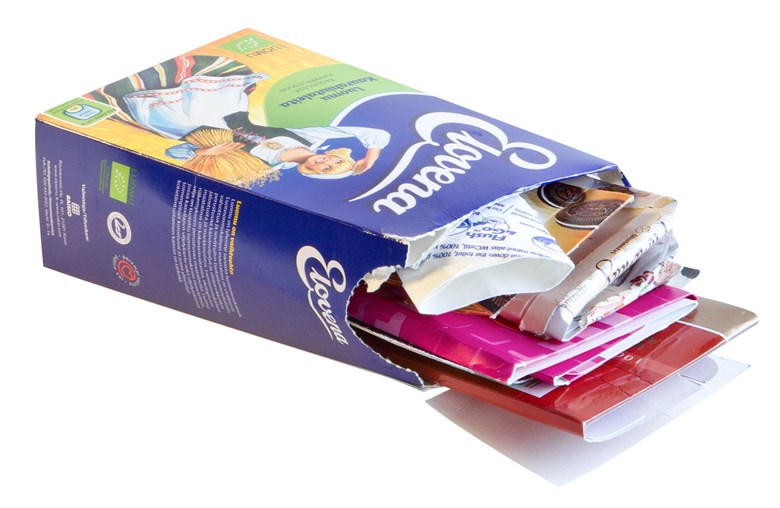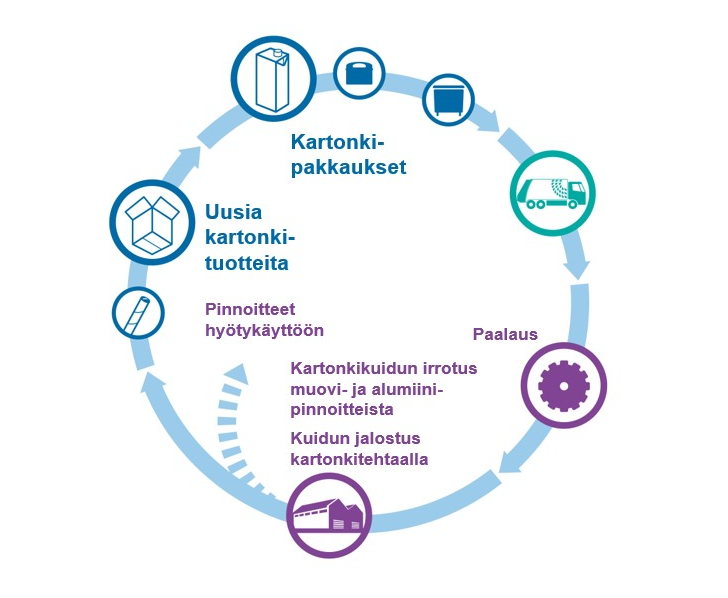Carton and cardboard

Packages made of carton, paper and cardboard belong in the carton collection.
What is allowed in the carton packaging collection?
- Liquid packaging made of carton, such as milk and juice cartons (also with aluminium lining)
- Carton packages, such as cereal and cookie packages
- Paper bags, such as bags for bread and flour
- Paper bags
- Wrapping papers, such as copying paper wrappers (but no print dyed gift wrapping paper)
- Egg cartons
- Kitchen paper and toilet paper cores
- Corrugated cardboard and kraft paper
- Packages to be sorted as carton packaging can also be identified by the codes marked next to the triangle symbol: PAP 21 (carton), PAP 22 (paper), PAP 20 (corrugated cardboard). Liquid packaging made of carton with the codes C/PAP 81 (carton + plastic) and C/PAP 84 (aseptic - carton, plastic, aluminium) can also be sorted as carton packaging.
What to do:
-
1
Sort carton and liquid packaging made of carton, paper packaging and cardboard packaging for carton packaging collection.
-
2
Remove food scraps from the packaging and clean if necessary. Drain off the liquids from juice or milk containers and rinse.
-
3
Let the packaging drip dry. The packaging is sufficiently clean and dry if you can store it for a few days at home without any odour or mould problems. Mould spoils the packaging, rendering its raw material no longer usable as carton.
-
4
Caps which come off of packaging are sorted into plastic packaging waste collection. It is not necessary to remove caps, staples or packaging tape attached to the packaging.
-
5
Flatten carton and cardboard packaging and pack them nested inside each other, so that they take up less space in the waste container.
Please note! Also flatten milk and juice containers, but do not nest them too tightly inside each other. The recycling process at the facility is more successful when these containers are packed slightly more loosely.
What is not allowed in the carton collection?
- Packaging with food residues that have not been rinsed and/or scraped off > mixed waste
- Gift wrapping paper > mixed waste
- Hobby cardboard > mixed waste
- Styrofoam > mixed waste, packaging together with plastic packaging
- Bubble wrap and other plastic packaging fillers > plastic packaging
- Plastic bags and boxes > plastic packaging
Where to take carton packaging?
- The carton collection container of the property
- Rinki eco take-back points
- Sortti Stations
Dry and clean cardboard and carton other than packaging, such as protective cardboard and cardboard moving boxes, can also be taken to Sortti Stations free of charge. Companies’ large loads of cardboard and carton packaging (van loads) must be taken to reception terminals for fibre packaging.
What is carton used for?

From the container, the carton will be transported to the sorting plant for baling. The bales are then transported to carton mills, where they are used as raw material. Once there, the carton fibres are fed into a massive washing machine known as a pulper. The pulper separates the fibres from each other and from any coating material. The fibres then continue to a carton machine.
The coating material extracted from the fibres is mostly plastic. The coating is dried and transported to a power plant, where it is burned to generate heat and energy. Some of the aluminium coating included in carton packages is separated and recycled for use as raw material in new products.
Carton fibre is used to make products such as corrugated cardboard raw material, envelopes, lamination papers, and cores for paper and fabric rolls. A part of the collected carton will end up being used for new carton packages.